Question (6 marks)
Many years ago, people believed that all the planets and the Sun orbited Earth. This is known as the geocentric model. As viewed from Earth, Mars takes the path shown in the animation.
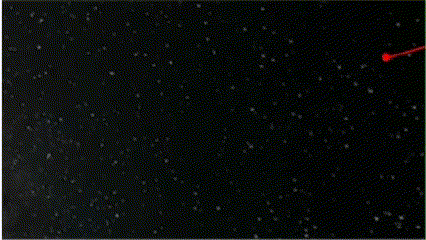
Question a (2 mark)
Suggest why this observation is not consistent with the geocentric model of the solar system.
▶️Answer/Explanation
Ans:
Mars seems to change the direction and if earth is considered to be at the center then mars would orbit in a circular path and therefore, this observation is not consistent with the geocentric model of the solar system.
Question b (2 mark)
When Earth and Mars are $6 \times 10^{10} \mathrm{~m}$ apart, a radio signal travelling at $3 \times 10^8 \mathrm{~ms}^{-1}$ will take $200 \mathrm{~s}$ to travel between the planets.
Calculate the time for the radio signal to travel from Earth to Mars when they are $4 \times 10^{11} \mathrm{~m}$ apart. Give your answer to the nearest minute.
▶️Answer/Explanation
Ans:
time for the radio signal $=\frac{\left(4 \times 10^{(11)}\right)}{3 \times 10^8}=1333.333333$
time for the radio signal in $\min =\frac{1333.33}{60}=22.22216667$
time for the radio signal in $\mathrm{min} = 22 \mathrm{~min}$
Question c (2 mark)
The UAE (United Arab Emirates) launched an un-crewed mission to Mars on 19 July 2020. Similar missions from China and the US (United States) were launched around the same date. The orientation of Earth and Mars on this date is shown below.
The planets were closest together on 6 October 2020 .

Use the diagrams to suggest two reasons why it was an advantage to launch the missions to Mars in July rather than October.
Reason 1:
Reason 2:
▶️Answer/Explanation
Ans:
Reason 1: the launch date is calculated to give the shortest journey time
Reason 2: the launch date gives the shortest distance to travel which as a result save fuel for the mission.
Question (13 marks)
Since 1960, there have been around 47 missions to Mars launched. Of these, only around half have been successful and have collected data to extend our knowledge of Mars. The interactive graphic below shows details of the missions.
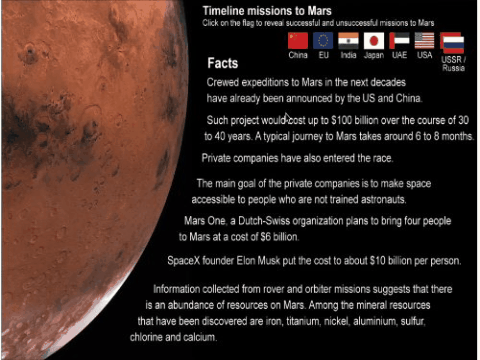
- the technical challenges of planning the journey to Mars
- a discussion of the economic advantages and disadvantages for the government
- a discussion of the political implications of attempting to put a human on Mars
- a concluding appraisal.
▶️Answer/Explanation
Ans:
Sending humans to mars is an ambitious endeavor that requires significant technical, economic and political investments. However, several governments have expressed interest in exploring mars which led to various successful and unsuccessful events in the past.
Technical challenges:
One of the most significant challenges of planning a mission to mars is the distance and the associated time delay. Mars is about 140 million miles away from the earth and depending on the alignment of the planets, a trip to mars can take anywhere between 6 to 8 months. During the journey, astronauts will be exposed to high radiation levels and low levels of gravity, which can cause several health issues. Additionally, Mars has a thin atmosphere, making it challenging to land safely, and the planets extreme temperature fluctuations pose challenges for the equipment and the crew.
Economic Advantages:
Despite the technical challenges, there are several economic advantages to sending humans to mars. First, the mission can stimulate technological advancements and innovations that can have practical applications on earth. For example, advancement in life support, radiation shielding and propulsion in healthcare, transportation and energy industries. Additionally, a mars mission can create jobs and drive economic growth, as it requires a significant workforce in engineering, manufacturing and research and development.
Economic Disadvantages:
On the flip side, a mars mission can also be an expensive endeavor, costing upto 100 billion dollars over 20 to 40 years. Governments have to invest in research, developments and testing of new technologies, spacecraft and launch vehicles which can significantly strain their budgets. Moreover, space exploration is a long-term risky investment, as there are many chances of unsuccessful mission, as in case of USSR/Russia, where the governments has invested billions of dollars from 1960-2016 and not even a single mission was successful. Thus, its a matter of challenge for governments looking for short-term benefits.
Political Implications:
The Political Implications of attempting to put a human on mars are significant. A Mars mission can symbolise national prestige and technological leadership, showcasing a country’s scientific and technological prowess. This can be a source of pride for citizens, fostering national unity and inspiring future generations of scientist and engineers. Additionally, international cooperation in a mars mission can promote diplomatic relations and help build alliances.
However the political implications can also be negative. The high costs of the mission can lead to criticism from taxpayers and politicians, who might question the prioritization of space exploration over other pressing national issues. Moreover, space exploration is a highly politicized issue and the mission can become a subject of political controversy and influence public opinion on government spending.
In conclusion, a government’s decision to attempt to send humans to mars is a complex one, requiring careful consideration of the technical, economic and political implications. While a mars mission can bring significant benefits in terms of technological advancements, economic growth, and national prestige, it also comes with significant challenges and risks. Governments must weigh the benefits and risks carefully and make informed decisions based on a long-term vision for space exploration and a commitment to scientific advancement.
Question (12 marks)
Satellites can be used to access the internet.
Discuss and evaluate the advantages and disadvantages of internet access using satellites compared to traditional cable-based internet access. In your answer you should include:
- an advantage of satellite internet access
- a disadvantage of satellite internet access
- technological considerations
- economic factors
- a concluding appraisal.
▶️Answer/Explanation
Ans:
Advantages of Satellite Internet Access:
One significant advantage of satellite internet access is its ability to provide connectivity in remote or rural areas where traditional cable-based internet infrastructure may be unavailable or economically unfeasible. Satellite internet relies on a network of orbiting satellites that can cover vast geographical areas, allowing for global coverage and reaching underserved regions. This makes it a valuable solution for bridging the digital divide and providing internet access to areas that would otherwise have limited connectivity options.
Disadvantages of Satellite Internet Access:
Despite its wide coverage, satellite internet access has certain drawbacks. The most notable disadvantage is the issue of latency and signal delay. Since the signals have to travel a considerable distance between Earth and the satellite in space, it introduces a noticeable delay in the transmission. This delay, known as latency, can result in slower response times, making real-time applications such as online gaming, video conferencing, or VoIP communication challenging. Activities that require immediate interaction may be negatively impacted by the inherent signal delay in satellite internet.
Technological Considerations:
One technological consideration is the limited bandwidth of satellite internet compared to cable-based internet. The available frequency spectrum for satellite communication is shared among many users, leading to potential congestion and reduced speeds during peak usage times. This congestion can affect the overall performance and user experience, especially for bandwidth-intensive activities such as streaming high-definition videos or downloading large files.
Additionally, satellite internet connections are susceptible to weather interference. Adverse weather conditions, such as heavy rain or snow, can attenuate or interfere with the satellite signals, causing disruptions or service degradation. This atmospheric interference can impact the reliability of satellite internet connections, leading to potential outages or decreased performance during inclement weather.
Economic Factors:
Satellite internet access tends to be more expensive than traditional cable-based internet. The costs associated with launching and maintaining satellites, along with the need for specialized receiving equipment, contribute to the higher costs. Additionally, the limited bandwidth available on satellites may result in usage-based pricing plans, where users are charged based on their data consumption. This can be costlier for heavy internet users or businesses that require significant data usage.
Concluding Appraisal:
In conclusion, satellite internet access provides a crucial solution for connecting remote areas and bridging the digital divide. It offers wide coverage and the ability to reach places that are difficult to access via traditional cable-based infrastructure. However, it comes with trade-offs, including high latency, limited bandwidth, and susceptibility to weather interference. These technological limitations, along with the higher costs, can impact the user experience and affordability.
While satellite internet may not provide the same level of performance and reliability as cable-based internet, it remains a valuable alternative for areas without access to traditional infrastructure. Its advantages in terms of wide coverage and ability to reach remote regions outweigh the disadvantages in certain situations. Considerations of technological limitations and economic factors are essential when evaluating the suitability of satellite internet access compared to traditional cable-based internet access.
Question (5marks)
Question a (2 mark)
The following table contains information that can be used to describe mass or weight.
Select the correct option to complete the table.
$\begin{array}{lll}\text { newton } & \text { size only } & \text { independent of gravitational field strength } \\ \text { kilogram } & \text { size and direction } & \text { dependent on gravitational field strength }\end{array}$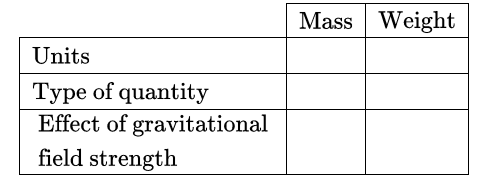
▶️Answer/Explanation
Ans:
Here is the completed table:

Explanation:
- Mass is measured in kilograms (kg) and is a quantity that only considers the size or amount of matter in an object. It does not depend on the gravitational field strength. So, the options “kilogram,” “size only,” and “independent of gravitational field strength” are correct for the “Mass” row.
- Weight is measured in newtons (N) and is a quantity that takes into account both the size and direction of a force due to gravity acting on an object. Weight depends on the gravitational field strength, which can vary depending on the location. Therefore, the options “newton,” “size and direction,” and “dependent on gravitational field strength” are correct for the “Weight” row.
Question b (2 mark)
The table below contains information about four planets in the solar system. Using this information, select the three unnamed planets and complete the table.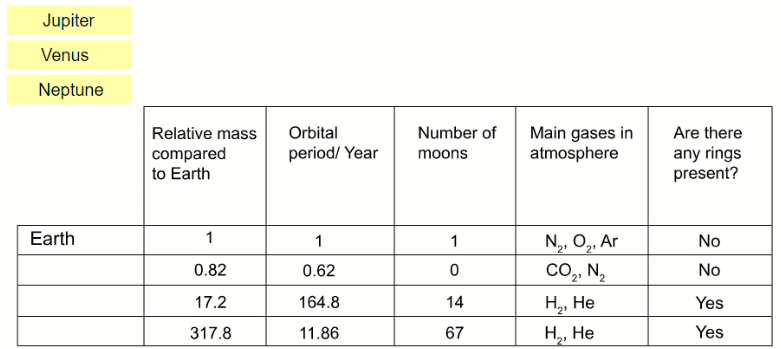
▶️Answer/Explanation
Ans:
Here is the completed table with the three unnamed planets:

Explanation:
- Venus has a relative mass of 0.82 compared to Earth, an orbital period of 0.62 Earth years, no moons, its main atmospheric gases are carbon dioxide (CO$_2$) and nitrogen (N$_2$), and it does not have any rings.
- Neptune has a relative mass of 17.2 compared to Earth, an orbital period of 164.8 Earth years, 14 moons, its main atmospheric gases are hydrogen (H$_2$) and helium (He), and it has rings present.
- Jupiter has a relative mass of 317.8 compared to Earth, an orbital period of 11.86 Earth years, 67 moons, its main atmospheric gases are hydrogen (H$_2$) and helium (He), and it has rings present.
Question c (1 marks)
State why the outer planets tend to be colder than the inner planets.
▶️Answer/Explanation
Ans:
The outer planets tend to be colder than the inner planets due to their larger distances from the Sun. The amount of solar radiation received decreases with increasing distance from the Sun, so the outer planets receive less solar energy compared to the inner planets. This reduced amount of incoming solar radiation results in lower temperatures on the outer planets. Additionally, the outer planets are primarily composed of gas and have thicker atmospheres, which can contribute to trapping heat and further lowering their temperatures.
Question (3 marks)
The first animation shows the Moon orbiting the Earth. | The second animation shows how the Moon looks each day, when viewed from the Earth over a complete month. |
Question a (2 mark)
Using the information from both animations, describe why the appearance of the Moon changes over a month.
▶️Answer/Explanation
Ans:
The appearance of the Moon changes over a month due to two main factors:
1. Moon’s Orbit: The Moon orbits around the Earth in an elliptical path, completing one revolution in approximately 27.3 days. As the Moon travels along its orbit, its position relative to the Earth and the Sun changes. This changing position results in different amounts of sunlight reflecting off the Moon’s surface, which in turn affects its appearance when viewed from Earth.
2. Sunlight Illumination: The second animation shows how the Moon looks each day from the perspective of an observer on Earth. As the Moon orbits the Earth, the relative positions of the Moon, Earth, and Sun change, causing varying portions of the Moon’s surface to be illuminated by sunlight. The amount of illumination visible from Earth determines the Moon’s phase, such as full moon, half moon, crescent, or new moon, leading to the observed changes in the Moon’s appearance over a month.
Question b (1 mark)
The Moon affects the tides on Earth. Identify the force that produces this effect.
▶️Answer/Explanation
Ans:
The force that produces the effect of tides on Earth due to the Moon is known as the gravitational force.
Question (16 marks)
Communication in the modern world relies on transmission using satellites. Pictures, documents, videos and songs are examples of information that can be converted into electromagnetic waves. The electromagnetic waves are sent from a ground station to a satelliteand then retransmitted to a second station on Earth. Satellite transmission means that the electromagnetic waves can be sent over much larger distances than are possible with ground transmission.
The animation shows a simple model of a satellite transmission where $s$ is the ground distance between the two stations, $h$ is the height of the satellite above the surface of the Earth and the P marks show the limits of the satellite footprint. Signals travel at the speed of light from the ground station to the satellite and back.
A study is performed to determine if there is a relationship between ground distance $(s)$ and transmission time $(t)$.
Question a (2 mark)
Identify the independent, dependent and control variables for this experiment.
transmission time $t$ :
height $h:$
ground distance $s$ :
▶️Answer/Explanation
Ans:
Independent variable: Ground distance $(s)$
Dependent variable: Transmission time $(t)$
Control variable: Height $(h)$
In this experiment, the independent variable is the ground distance $(s)$ between the two stations. The researcher would manipulate and control this variable by selecting different distances to measure the corresponding transmission times.
The dependent variable is the transmission time $(t)$. This variable is measured and recorded based on the chosen ground distances.
The control variable is the height $(h)$ of the satellite above the surface of the Earth. By keeping the satellite height constant, the researcher ensures that any observed relationship between ground distance and transmission time is not influenced by variations in satellite height.
Question b (3 mark)
Formulate and justify a hypothesis about the relationship between the variables for this study.
▶️Answer/Explanation
Ans:
Hypothesis: As the ground distance $(s)$ between the two stations increases, the transmission time $(t)$ will also increase.
Justification:
Based on the given information and the principles of satellite transmission, it can be hypothesized that there is a positive relationship between the ground distance and the transmission time. This hypothesis is formed considering the following factors:
1. The speed of light: Signals travel at the speed of light from the ground station to the satellite and back. Since the transmission time is influenced by the speed of light, which remains constant, any changes in the ground distance are expected to affect the total transmission time.
2. Longer distance, longer time: As the ground distance between the two stations increases, the electromagnetic waves must travel a greater distance. This increased distance would require more time for the signals to reach the satellite and be retransmitted back to the second station on Earth.
3. No mention of signal degradation: The information provided does not mention any signal degradation or other factors that could impact the transmission time. Therefore, it is reasonable to assume that the primary factor affecting the transmission time in this experiment would be the ground distance.
Considering these factors, the hypothesis states that as the ground distance between the two stations increases, the transmission time will also increase.
Question c (2 mark)
Describe the effect an unexpected change of the control variable would have on the independent and dependent variables.
Independent variable:
Dependent variable:
▶️Answer/Explanation
Ans:
Independent variable: Ground distance (s)
Dependent variable: Transmission time (t)
If there is an unexpected change in the control variable, which in this case is the height (h) of the satellite above the surface of the Earth, it would have the following effects on the independent and dependent variables:
Independent variable (Ground distance, s):
The unexpected change in the control variable would not directly impact the independent variable, which is the ground distance (s). The ground distance is still determined and manipulated by the researcher independently of the control variable.
Dependent variable (Transmission time, t):
The unexpected change in the control variable, i.e., the height (h) of the satellite, could have an indirect effect on the dependent variable, which is the transmission time (t). Changes in the height of the satellite can influence the overall system and introduce additional factors that affect the transmission time.
For example, if the height of the satellite decreases unexpectedly, it may result in a shorter transmission path between the ground stations. This could potentially reduce the overall transmission time.
Conversely, if the height of the satellite increases unexpectedly, it would elongate the transmission path, resulting in a longer transmission time.
In summary, while an unexpected change in the control variable (satellite height) may not directly impact the independent variable (ground distance), it can indirectly influence the dependent variable (transmission time) by introducing additional factors that affect the overall system.
Question d (2 mark)
Use the animation to outline why there is a maximum possible ground distance between stations.
▶️Answer/Explanation
Ans:
The animation helps illustrate why there is a maximum possible ground distance between stations in satellite transmission. Here’s an outline:
1. The animation shows a simple model of a satellite transmission, where the ground stations are connected through a satellite positioned above the Earth’s surface.
2. The P marks in the animation represent the limits of the satellite’s footprint, which indicate the coverage area where the satellite can receive and transmit signals.
3. As the ground distance between the two stations increases, the length of the transmission path also increases.
4. However, there is a maximum possible ground distance beyond which the transmission path becomes too long for the satellite to maintain a stable connection and efficient signal transmission.
5. This maximum possible ground distance is determined by the limitations of the satellite’s coverage area, as represented by the P marks in the animation.
6. When the ground distance exceeds the limits of the satellite’s footprint, the signal from the ground station may become too weak or distorted to be effectively received by the satellite.
7. Additionally, the longer the transmission path, the greater the potential for signal loss, interference, or degradation due to factors such as atmospheric conditions, signal attenuation, and obstacles in the signal path.
8. Therefore, to ensure reliable and efficient satellite transmission, there is a practical limit to the ground distance between stations, beyond which the quality and effectiveness of the transmission may significantly deteriorate.
In summary, the animation demonstrates that there is a maximum possible ground distance between stations in satellite transmission due to the limitations of the satellite’s coverage area, signal strength, and potential signal degradation over longer transmission paths.
Question e (2 mark)
In the animation above, the value of $s$ can be set to small values (even zero).
Explain why in a real situation, satellite transmission would not even be considered for small distances.
▶️Answer/Explanation
Ans:
In a real situation, satellite transmission would not be considered for small distances due to the following reasons:
1. Cost-effectiveness: Satellite transmission involves the deployment, maintenance, and operation of satellites, which incurs significant costs. For small distances, ground-based transmission methods, such as cables or wireless communication, are more cost-effective and efficient. Setting up and maintaining a satellite infrastructure for short distances would be economically impractical.
2. Signal propagation delay: Satellite transmission involves sending signals to a satellite in space and receiving them back on Earth. This process introduces a noticeable signal propagation delay. For small distances, the time required for the signals to travel to the satellite and back would be relatively longer compared to ground-based transmission methods, which can directly transmit signals with negligible delay. The added delay in satellite transmission for short distances may not be desirable for real-time applications or situations where low latency is crucial.
Considering these factors, satellite transmission is not considered for small distances in real situations due to the cost-effectiveness of alternative methods and the added signal propagation delay associated with satellite communication.
Question f (2 mark)
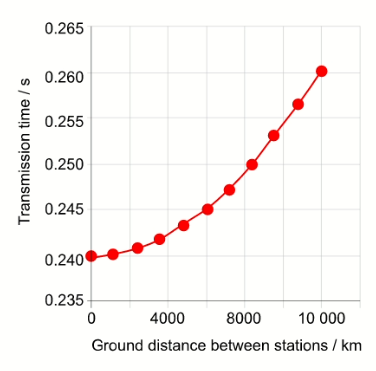
The graph shows data collected from the satellite animation. Comment on the shape of the graph.
▶️Answer/Explanation
Ans:
Question g (2 mark)
Use your answer to part (f) to select the correct option. Justify your answer.

Justification
▶️Answer/Explanation
Ans:
Question (6 marks)
Mars will be an unwelcoming place for humans because of its atmosphere and environment.
- the effect of temperature
- the effect of radiation
- the effect of low gravity
- a suggestion for how each of these effects can be overcome.
▶️Answer/Explanation
Ans:
Establishing a settlement on mars is a complex and challengin endevour that requires the applications of scientific principles to create appropriate living condtions for humans.
Effect of temperature:
Mars has an average temperature of $-62{ }^{\circ} \mathrm{C}$ and extreme temperature fluctuations, with temperatures ranging from $-126^{\circ} \mathrm{C}$ in winter to $21^{\circ} \mathrm{C}$ in summer and the night-time temperature can be $90^{\circ} \mathrm{C}$ lower than daytime temperatures. Therefore, one of the primary challenges of establishing a settlement on mars is to create a habitat that can maintain a stable and comfortable temperature for humans.
One way to overcome this challenge is to use insulation to regulate the temperature inside the habitat. Insulation materials such as fiberglass, polyethylene foam can be used to create a barrier between the interior and exterior of the habitat, preventing the heat loss and mainlining a stable temperature.
Effect of Radiation:
Mars has a thin atmosphere, the layer of gas is 100 times thinner than Earth’s and the atmospherics pressure is far lower. There is no protection from the sun’s radiation on mars. The amount of high-energy UV radiation from the sun is many times greater than on Earth. Radiation exposure can cause several health issues for humans, including cancer, genetic mutations and central system damage.
To overcome the radiation challenge, habitats on mars can be built with radiation-shielding materials, such as water, concrete or polyethylene. These materails can absorb or deflect radiation, reducing the exposure levels inside the habitat.
Effect of low gravity:
the gravitational field strength on the surface of Mars is 0.38 times that of earth, which can cause several health issues for humans, including muscle and bone loss, cardiovascular problems and vision impairment.
To overcome the low-gravity challenge, habitats on mars can be designed with artificial gravity systems, such as rotating habitats. These systems can simulate earths gravity providing a comfortable and health living environment. Additionally, astronauts can perform regular exercise routines to maintain their physical health and wear a weighted suit to mitigate the effects of low-gravity.
In Conclusion, scientific principles can be applied to build appropriate living conditions for humans on mars by addressing all the issues considered above and considering the solutions to overcome the same.
Question:
If the Earth were shrunk to the size of a football with a radius of 11cm, how high would Mount Everest be?
▶️Answer/Explanation
Ans: \(\frac{0.11}{6371000}\times 8848=1.5\times 10^{-4}m\)
The Earth’s radius is slightly different if it is measured to the poles or to the equator. The distance from the center of the Earth to the poles, the polar radius, is 6,356.8km whereas the distance to the equator, the equatorial radius, is slightly larger at 6,378.1km.
Question:
If the Earth were shrunk to a polar radius of 11cm, by how much would the equatorial radius be larger?
▶️Answer/Explanation
Ans: (0.11 × 6,378.1) × 6,356.8 = 0.1103; 0.1103 – 0.11 = 0.0003 m = 0.3 mm
Question:
Show that 7° is about 1/50 of the circumference of a circle.
▶️Answer/Explanation
Ans: \(\frac{7}{360}=0.019;\frac{1}{50}=0.02.\)
Question:
Eratosthenes calculated that the distance between Syene and Alexandria, 5,000 stadia, represented the same fraction, 1/50, of the Earth’s circumference. Use your answer above to calculate Eratosthenes’s circumference of the Earth (giving your answer in stadia).
▶️Answer/Explanation
Ans: \(\frac{5000}{0.019}=2.63\times 10^{5}stadia\)
Question:
If one stade is 160m, calculate the circumference of the Earth in meters.
▶️Answer/Explanation
Ans: 2.63 × 105 × 160 = 4.21 × 107 m = 42,100 km
Question:
Compare this answer to the value that is currently accepted.
▶️Answer/Explanation
Ans: Value that is currently accepted = 40,075 km Eratosthenes’ estimate was about 2,000 km higher than todays accepted value – only 5% difference.
Creating a scale model of the solar system
The following table gives the sizes of the planets and their distances from the Sun
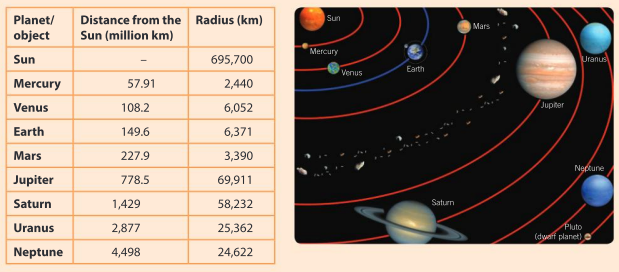
Consider the following questions
Question:
Why is the Sun not drawn to scale in the picture above? Measure one planet and calculate how many times smaller it has been drawn. By applying the same scale factor, how big would the Sun have to be at that scale? How far away would it have to be?
▶️Answer/Explanation
Ans: Example: Diameter of Jupiter = 1.7 cm in picture; scale factor = \(\frac{69911000}{0.0085}=8.22\times 10^{9};\) with same scale factor, Sun would have a radius of 8.5 cm and so would be 17cm in diameter; this would not fit in the picture.
Question:
Measure the size of the Sun in the picture and work out how far away the Earth would be on that scale. How far away would Neptune be? How big would the Earth be on this scale?
▶️Answer/Explanation
Ans: Radius of Sun in picture \(=\frac{0.7}{2}=0.35 cm;\) scale factor \(=\frac{695700000}{0.0035}=1.99\times 10^{11}times;\) On this scale:
Distance of Earth from Sun \(=\frac{149.6\times 10^{9}}{1.99\times 10^{11}}\)
= 0.752 m = 75.2 cm
Distance of Neptune from Sun \(=\frac{4498\times 10^{9}}{1.99\times 10^{11}}\)
= 22.6 m
Radius of Earth \(=\frac{6371\times 10^{3}}{1.99\times 10^{11}}=3.20\times 10^{-5}m\)
= 0.032 mm
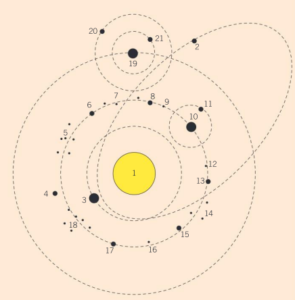
Another solar system
Question:
Planets that orbit other stars are being discovered frequently. Suppose you were to discover another solar system. A drawing of it is shown to the right. Identify which of these objects is most likely to be:
● a star
● a planet
● a dwarf planet
● a moon
● an asteroid.
▶️Answer/Explanation
Ans:
Star: 1
Planet: 3, 19
Dwarf planet: 10 (and maybe others – we cannot see if it
is round or not)
Moon: 11, 20, 21
Asteroid: 2, 4–9, 12–18
Question:
If the Sun (M = 2 × 1030 kg) were to be compressed into a black hole, what would the radius of the event horizon be?
▶️Answer/Explanation
Ans: \(\frac{2\times 6.67\times 10^{-11}\times 2\times 10^{30}}{(3\times 10^{8})^{2}}=3\times 10^{3}m\)
Question:
The supermassive black hole at the center of our galaxy is believed to have a mass of 8.2 × 1036 kg. Calculate the radius of its event horizon.
▶️Answer/Explanation
Ans: \(\frac{2\times 6.67\times 10^{-11}\times 8.2\times 10^{36}}{(3\times 10^{8})^{2}}=1\times 10^{10}m\)
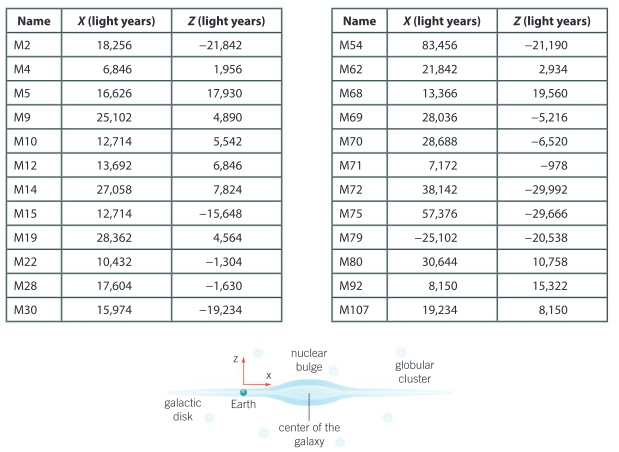
Most of the stars in the Milky Way exist in the galactic disk and the nuclear bulge. Dust obscures our view of the galactic center but globular clusters can help us to locate the center of the galaxy
Question:
By taking an average of the X and Z coordinates, estimate the coordinate for the center of the galaxy.
▶️Answer/Explanation
Ans: Average X coordinate \(=\frac{516384}{24}=21516\)
Average Z coordinate \(=\frac{67482}{24}=-2811.75\)
A graph showing the coordinates of the globular clusters is shown below.
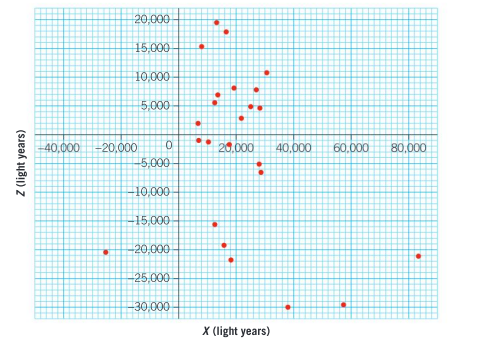
Question:
Plot the location of the galactic center on a copy of this graph.
There are various factors which might affect the reliability of this estimate:
● all these globular clusters were observed from France by Charles Messier in the 18th century (this is why their names all begin with M)
● distant globular clusters are fainter and harder to observe.
▶️Answer/Explanation
Ans: 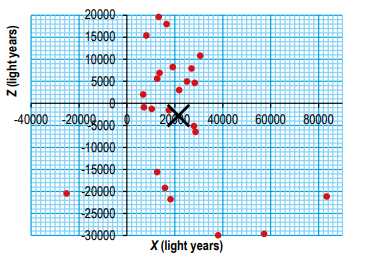
Question:
Which of these factors might best explain why there are no clusters plotted in the top left quadrant of the graph (negative X values, positive Z values)?
▶️Answer/Explanation
Ans: The location of Messier. He could only see globular clusters that are in the sky above the northern hemisphere.
Question:
How might these limitations of the data affect the value you obtained for the location of the center of the galaxy?
▶️Answer/Explanation
Ans: The limitations of the data mean that the value calculated for the center of the galaxy is not reliable. As there would likely be more points in the top left quadrant, the Z coordinate of the center of the galaxy would be more negative.
Summative assessment
Exoplanets
Question:
Give one difference between an exoplanet and the star that it orbits. Hence, explain why it is so difficult to observe exoplanets.
▶️Answer/Explanation
Ans: Stars emit their own light; exoplanets do not (only reflect light); star is a lot brighter and easier to see. Also accept that exoplanets are much smaller than the star.
An exoplanet should fit the definition of a planet in our own solar system, with the only difference being that it orbits a different star.
Question:
Give the definition of a planet in our solar system.
▶️Answer/Explanation
Ans: (It is not so massive that it starts fusion); it orbits the sun; it is sufficiently massive that it becomes round in shape; it clears the neighbourhood around its orbit.
In 1995, the first exoplanet in orbit around a star like our Sun was confirmed. The mass of the planet was about half the mass of Jupiter, but it orbited very close to its parent star so that it completed one orbit every four days.
Question:
Which of the definitions of a planet can this exoplanet demonstrate? Why is it reasonable to assume that it fits the description of a planet?
▶️Answer/Explanation
Ans: As the planet is half the mass of Jupiter, it should be sufficiently massive to have become round in shape (i.e. more massive than earth); it orbits its parent star; cannot assess whether it has cleared its orbit; reasonable to assume that it can be classified as a planet since a planet of this size in the solar system would have cleared its orbit.
Astronomers are particularly interested in planets which lie in the habitable zone, which is defined as the range of orbits where water could be present on a planet in its liquid state.
Question:
Explain why a planet might not be in the habitable zone if its orbit is too close or too far away from its parent star.
▶️Answer/Explanation
Ans: Temperature depends on distance to the star; too close – too hot for liquid water; too far away – too cold for liquid water.
Question:
Explain how the range of the habitable zone would change around a star much smaller than our Sun.
▶️Answer/Explanation
Ans: Smaller star emits less power/energy; habitable zone would be closer to the star.
Discovering exoplanets
The Kepler telescope monitors about 150,000 stars and can detect the change in their light if a planet passes in front of the star. As of 2017, about 3,500 exoplanets had been confirmed orbiting 2,600 stars.
Question:
Using the information above, calculate:
a) the fraction of stars which have planets
▶️Answer/Explanation
Ans: \(\frac{2600}{150000}=\frac{13}{750}\)
b) the average number of planets per star.
▶️Answer/Explanation
Ans: \(\frac{3500}{2600}=1.4\)
Question:
Explain why, in reality, both these numbers are likely to be larger.
▶️Answer/Explanation
Ans: Likely to be lots of exoplanets that have not yet been discovered; both values are underestimates.
Question:
A graph of the observed brightness of a star is shown below

a) Use the graph to find the orbital period of the planet.
▶️Answer/Explanation
Ans: 1 mark for measuring from dip to dip (e.g. 3.9 – 0.4 = 3.5 days);
2 marks for measuring across multiple dips (e.g. (14.7 – 0.2) ÷ 4 = 3.6 days)
b) How might the graph appear different if the planet was larger?
▶️Answer/Explanation
Ans: Dips would be wider; as the exoplanet would take longer to pass across the star; dips would be deeper; as more of the star’s light would be blocked by the exoplanet
c) Some exoplanet systems have many planets. Explain why many planets might make interpretation of the data more difficult.
▶️Answer/Explanation
Ans: Each exoplanet would give a set of dips; more exoplanets would create a set of different dips in the data; harder to distinguish which dips are due to which exoplanets; dips may overlap; longer time needed to observe pattern.
An exoplanet system
The star Kepler-296 is interesting to astronomers because it has five confirmed exoplanets in orbit around it. The table below shows some of the properties of these exoplanets. The units of orbital radius are astronomical units (AU) which is the average distance from the Earth to the Sun.
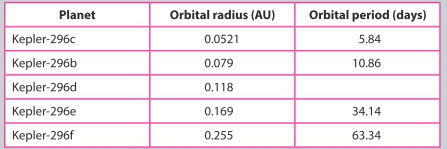
A graph of the data is shown below.
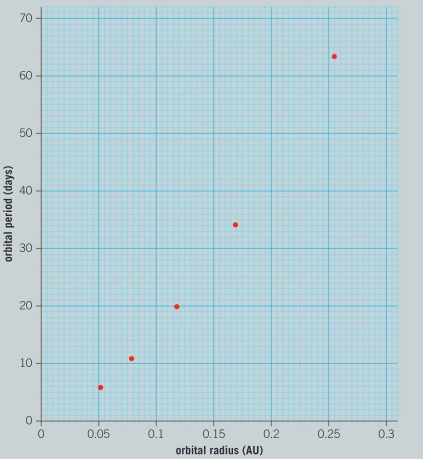
Question:
On a copy of this graph:
a) add a line of best fit
▶️Answer/Explanation
Ans: Curved line of best fit:
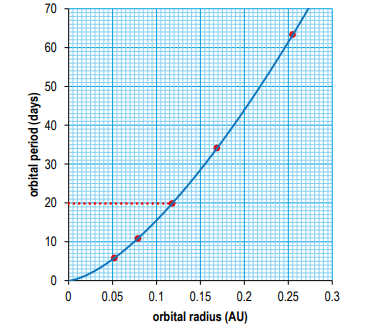
b) determine the orbital period for Kepler 296-d.
▶️Answer/Explanation
Ans: 20 days
Question:
Given that 1 AU = 1.5 × 1011m, calculate the circumference of the orbit of Kepler-296c and hence calculate its orbital speed. Give your answer in km h–1.
▶️Answer/Explanation
Ans: Use of 2πr; circumference = 0.0521 × 1.5 × 1011 × 2π = 4.91 × 1010 m; Speed \(=\frac{distance}{time};\) orbital speed \(=\frac{4.91\times 10^{7}}{5.84\times 24}=3.5\times 10^{5}km h^{-1};\) correct conversion to give answer in km h–1.
Question:
Most of the exoplanets that the Kepler telescope has found are large and have short time periods. Explain why this does not necessarily mean that these types of planets are the most common.
▶️Answer/Explanation
Ans: Easier to find large exoplanets; easier to find exoplanets with short time periods (takes a shorter length of time to observe them); more of these types of exoplanets will be discovered; average is skewed.
Although there are thousands of exoplanets that the Kepler mission has confirmed, many more thousands of potential observations have not been confirmed. To confirm the presence of an exoplanet, there must be multiple observations.
Question:
Explain why is it important to have multiple observations before confirming an exoplanet’s existence.
▶️Answer/Explanation
Ans: Eliminate anomalies; ensure observations are repeatable/reliable; also accept: might want to report other data (e.g. time period) so need further observations for measurement.
The search for extra-terrestrial life
The search for exoplanets has found many planets which share similarities with Earth. This raises the question of whether they might also have life on them. The following table contains data for some of these planets.

Question:
Explain why astronomers are interested in investigating whether other planets have life.
▶️Answer/Explanation
Ans: Award marks for good explanations. Points might include:
- increased knowledge of the conditions which are suitable for life;
- this knowledge can be applied to the conditions on earth;
- if there are many lifeforms in the galaxy then chances of intelligent life are higher;
- potential communications/threats to earth.
Question:
Assuming that alien life is very much like life on Earth, describe the advantages and disadvantages of the environments of these planets for supporting life.
▶️Answer/Explanation
Ans: One mark for an advantage/disadvantage of each planet. Some examples:
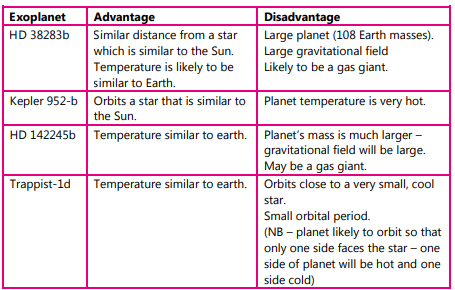
Question:
Suppose that a long time in the future, the Earth becomes uninhabitable and the human race has to travel to a new planet. Which of these planets do you think would be most suitable ?Explain your reasons.
▶️Answer/Explanation
Ans: Accept a reasoned argument based on the advantages and disadvantages in previous answer.
